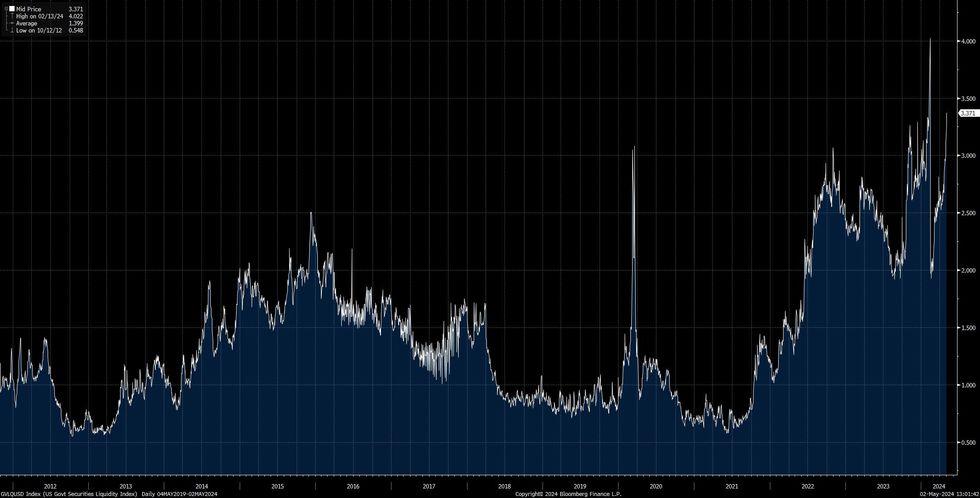-
Policy
Policy
Exclusive interviews with leading policymakers that convey the true policy message that impacts markets.
LATEST FROM POLICY: -
EM Policy
EM Policy
Exclusive interviews with leading policymakers that convey the true policy message that impacts markets.
LATEST FROM EM POLICY: -
G10 Markets
G10 Markets
Real-time insight on key fixed income and fx markets.
Launch MNI PodcastsFixed IncomeFI Markets AnalysisCentral Bank PreviewsFI PiFixed Income Technical AnalysisUS$ Credit Supply PipelineGilt Week AheadGlobal IssuanceEurozoneUKUSDeep DiveGlobal Issuance CalendarsEZ/UK Bond Auction CalendarEZ/UK T-bill Auction CalendarUS Treasury Auction CalendarPolitical RiskMNI Political Risk AnalysisMNI Political Risk - US Daily BriefMNI Political Risk - The week AheadElection Previews -
Emerging Markets
Emerging Markets
Real-time insight of emerging markets in CEMEA, Asia and LatAm region
-
Commodities
-
Credit
Credit
Real time insight of credit markets
-
Data
-
Global Macro
Global Macro
Actionable insight on monetary policy, balance sheet and inflation with focus on global issuance. Analysis on key political risk impacting the global markets.
Global MacroDM Central Bank PreviewsDM Central Bank ReviewsEM Central Bank PreviewsEM Central Bank ReviewsBalance Sheet AnalysisData AnalysisEurozone DataUK DataUS DataAPAC DataInflation InsightEmployment InsightGlobal IssuanceEurozoneUKUSDeep DiveGlobal Issuance Calendars EZ/UK Bond Auction Calendar EZ/UK T-bill Auction Calendar US Treasury Auction Calendar Global Macro Weekly -
About Us
To read the full story
Sign up now for free trial access to this content.
Please enter your details below.
Why MNI
MNI is the leading provider
of intelligence and analysis on the Global Fixed Income, Foreign Exchange and Energy markets. We use an innovative combination of real-time analysis, deep fundamental research and journalism to provide unique and actionable insights for traders and investors. Our "All signal, no noise" approach drives an intelligence service that is succinct and timely, which is highly regarded by our time constrained client base.Our Head Office is in London with offices in Chicago, Washington and Beijing, as well as an on the ground presence in other major financial centres across the world.
Real-time Actionable Insight
Get the latest on Central Bank Policy and FX & FI Markets to help inform both your strategic and tactical decision-making.
Free AccessSigns Of Impaired Liquidity Probably Factored Into Deeper Fed QT Taper
Bloomberg’s U.S. Tsy liquidity index warrants attention.
- While operating off multi-year peaks, the index sits above levels seen around the time of the initial COVID outbreak in ’20, hardly a sign of a well-functioning market.
- Fallout from the sharper-than-expected QT tapering announcement at yesterday’s FOMC decision ($35bn reduction in the monthly cap for Tsy sales vs. $30bn that was widely expected) will be in focus during the coming months.
- What guided the Fed’s decision to provide a more aggressive QT taper than almost everyone expected? We don’t know, the post-meeting line of questioning on the topic was weak to non-existent.
- Meanwhile, there was a lack of detail/further explanation surrounding Fed deliberations and any guidance from the SOMA desk.
- We would point to the liquidity measure flagged above as a potential ‘tell’ for at least some of the Fed's thinking.
- This also comes after the Treasury recently formalised its buyback schedule with a focus on liquidity management.
- Note that some sell-side names have tweaked their calls re: the length of the QT scheme, seeing yesterday’s move as a step towards prolonging the Fed’s balance sheet rundown.
Fig .1: Bloomberg U.S. Tsy Liquidity Index
 Source: MNI - Market News/Bloomberg
Source: MNI - Market News/Bloomberg
To read the full story
Sign up now for free trial access to this content.
Please enter your details below.
Why MNI
MNI is the leading provider
of intelligence and analysis on the Global Fixed Income, Foreign Exchange and Energy markets. We use an innovative combination of real-time analysis, deep fundamental research and journalism to provide unique and actionable insights for traders and investors. Our "All signal, no noise" approach drives an intelligence service that is succinct and timely, which is highly regarded by our time constrained client base.Our Head Office is in London with offices in Chicago, Washington and Beijing, as well as an on the ground presence in other major financial centres across the world.
